Translations:
Other Pages:
CEC Training Modules
Akan Studies Site Map
Sociology for beginners
Contact
Kompan Adepa
Go to the People
Ghana Web
Women II; Farming
by Phil Bartle, PhD
Farming is one of the four main ways that women are involved with food.
Farming
In the rain forest, farms tend to be small and have mixed crops. The big trees protect the plants and soil from too much sun and rain. Mixing crops slows the spread of parasites.
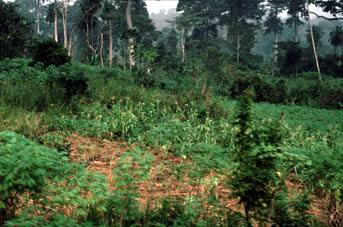 |
 |
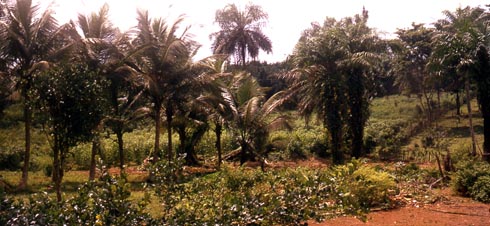 |
Farm
Cutting down the trees and using tractors and fertilizers, to copy farming methods in Europe and North America, have tended to be disasters, and produce hardening of the soil called lateritization, permanently removing the area from further farming.
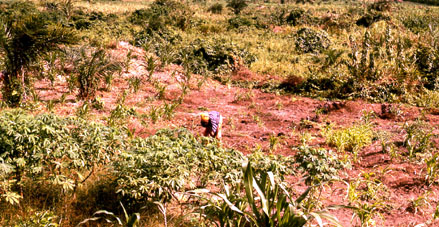 |
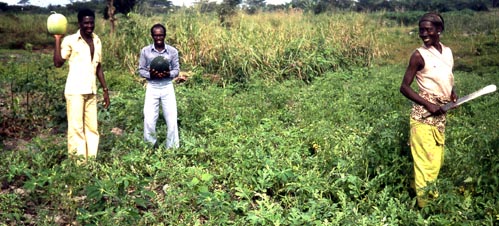 |
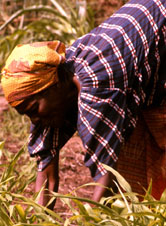 |
Farmer
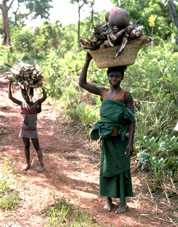 |
Farmer Carrying Head Load In Palm Branch Basket
In Canada farms tend to be owned and run by men, or by families with men as heads of those families. For those reasons, when we hear the word "farmer" we most likely think of male. In most of Africa South of the Sahara (a euphemistic way of saying in black African societies) about ninety per cent of the farmers are women, and about ninety percent of the farming is done by women.
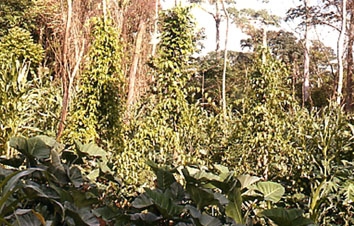 |
Omankene (Taro) Growing in a Rain Forest Farm
Roughly three hundred years ago, Arab sailors and traders brought the taro plant from where it was indigenous in the South Pacific, to the East coast of Africa. Planting and growing taro caught on and spread rapidly across Africa. Oral traditions indicate that it arrived in Kwawu about two centuries ago. An indigenous rain forest yam was called nkene. The new taro produced so much food, lots of starch in its roots and nutrition in its large green leaves, so they named in Omankene (oman means the state –– it was kene that would feed the state). In Pigeon English, it was called cocoa yam, because it was usually found on cocoa plantations. It grows well in wet dark soil under the large hardwoods. The root is usually boiled as a starch, and may be mashed. The leaves are a good source of greens, and taste delicious when parboiled and puréed, then cooked with smoked fish, fried tomatoes and onions. The taro starch is used in Canada to make arrow root biscuits.
 |
Goats on the Main street of a Village
There is no herding as such in the rain forest; the savannah to the north is more appropriate for that. Cows and horses cannot survive the deadly tsetse fly. Goats, sheep and chickens are the main livestock. Looking after them usually falls to women and children, and the animals are usually allowed to forage at will. They may be penned in the home compound at night. Only if they are taken to another location might they be tied up for fear they will run away.
Food Processing
 |
Drying Peppers and Cassava
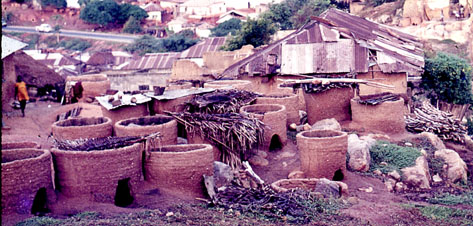 |
Fish Smoking
Extracting Palm Oils
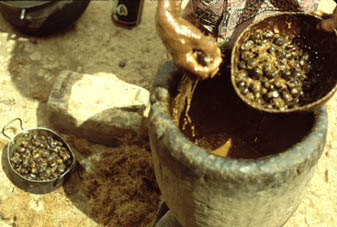 |
For more about women farming, see Oil Palm. For more about the Rain Forest, see Wood.
- Gender Hub
- Gender Introduction
- Gender Commensality ; Gender II
- Women I; Food
- Women II; Farming
- Women III (1): Cooking
- Women III (2): Cooking 2
- Women IV: Marketing
- Women V: Clay
- Men I: Wood
- Men II: Weaving
- Men III: Hunting
- Men IV: (1) Transport
- Men IV: (2) Transport
- Men and Women; (1) Oil Palm; Introduction
- Men and Women; (2) Oil Palm; Farming, Oil
- Men and Women; (3) Oil Palm; Wine Tapping
- Men and Women; (4) Oil Palm; Wine Marketting
- Men and Women; (5) Oil Palm; Other Products
- Men and Women; (1) Oil Palm; Conclusion